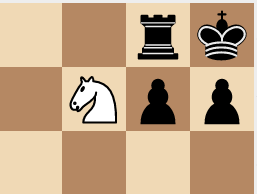
White follows with 2.Bd4, only to realize that the position is stalemate - Black's king is locked into the corner, with its only escape square covered by the knight on h6 the rook on g7 is pinned by the bishop, and cannot move without placing Black in check and all Black's pawns are blockaded by White pawns or pieces. Black plays 1.Kh8, the only legal move as the f7 square is covered by the knight and f8 by the bishop. White thinks he sees a faster win, and plays: 1.Nh6+ (1.Ne5 is better). Here White has the advantage in the endgame - the bishop and knight are worth slightly more than Black's rook, but it will take a long time to win.

However, stalemate can also occur in more complicated positions. Understanding of the above position is essential to the play of endgames, and is covered in detail in The Opposition, King vs King and single pawn. Therefore, because there are no legal moves, it is stalemate. However, with Black to move, the game is a draw, since the Black king is not in check but has no legal moves (all the available squares are attacked by either the White pawn or king, which would involve Black moving into check, which is illegal. If it is White to move, then 1.Kd6 forces the Black king to move to f7, after which 2.Kd7 wins, forcing the promotion of the pawn to queen on e8 next move, with a quick checkmate to follow. Note that the interpretation of this position depends entirely on which player is to move. King, in which the Black king is trapped on the back rank behind the White king and pawn: The simplest possible stalemate, and one of the most common, occurs in the endgame King and Pawn vs. If stalemate occurs, the game is declared a draw. In chess, stalemate occurs when the player to move has no legal move available, and is not in check. Unlike checkmate, which is derived from the Persian for The king is dead, stalemate entered the language in roughly 1765, with the 'mate' part taken from checkmate and 'stale' possibly coming from the Anglo-French estale, or " standstill". Stalemate: If a player has no check and no move.ĭraw: An understanding between players that the game is even.As with checkmate, stalemate has passed into common parlance as a word indicating a deadlock between two opposing sides, perhaps where neither side is willing to compromise, or where neither side is capable of winning the conflict. Checkmate (often shortened to mate) is a game position in chess and other chess-like games in which a player’s king is in check (threatened with capture) and there is no possible escape. So it is a stalemate and in turn a draw.Ĭheckmate: A check from which a King cannot escape. Here Black still wants to play, but he has no moves to make. It is the inability of white - who is not able to checkmate black, even after having 4 queens - which counts. character traitsBack-to-back printable mini-anchor-chart / personal word wall with character traits on one side and feelings / emotions on the other.(You can also print only the side that you are currently working on to provide students with a handy vocabulary word bank)Students can keep in their writing folder, in their book baggie, at literacy centers, etc. And you may think that Stalemate has helped black to manage a draw in the worst position. In the below diagram - though white has an obvious majority - it is a draw. Black to move but he has no legal moves to make even if he wants to. This is interesting because, consider the position below. Stalemate: If a player has no legal move and if there is no check, then it is considered to be a stalemate. The game is not automatically drawn if a position occurs for the third time – one of the players, on their move turn, must claim the draw with the arbiter.Ĥ. So, for instance, if a player has two knights and the knights are on the same squares, it does not matter if the positions of the two knights have been exchanged. Positions are considered the same if the same type of piece is on a given square. In chess, in order for a position to be considered the same, each player must have the same set of legal moves each time, including the possible rights to castle and capture en passant. The repeated positions do not need to occur in succession. Three-fold repitition: If a position occurs 3 times or will occur after their next move. Insufficient material: Both players lack sufficient material (piece/pawn) to checkmate the opponent.ģ.

Both the players will get 1/2 points when it is a draw.Ī draw happens for the following reasons.ġ.Mutual agreement: Both players agree on terms that they want a draw.Ģ.

Checkmate vs stalemate full#
White would get one full point whereas Black gets zero points.Ĭhess – like many other games- has draw. White is declared as the winner for trapping Black into a checkmate. There is not a single legal move that saves him from the check.

If a player can not get out of a check by any means then it is a checkmate.Ĭonsider the above position.


 0 kommentar(er)
0 kommentar(er)
